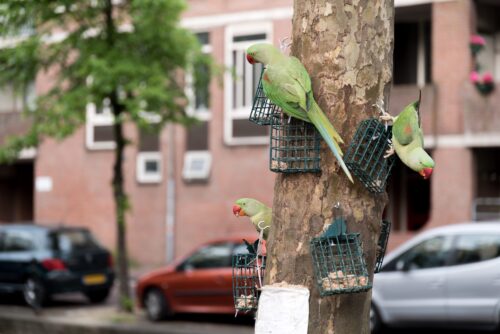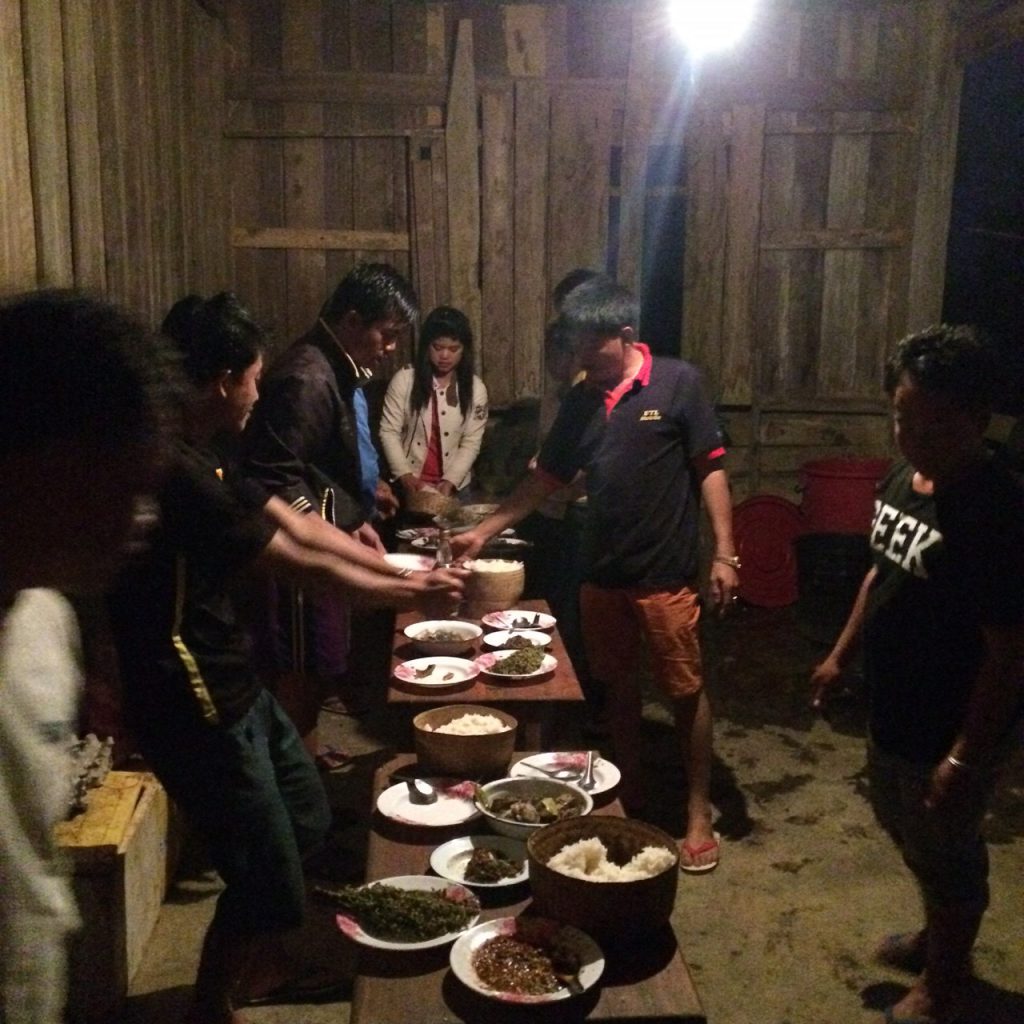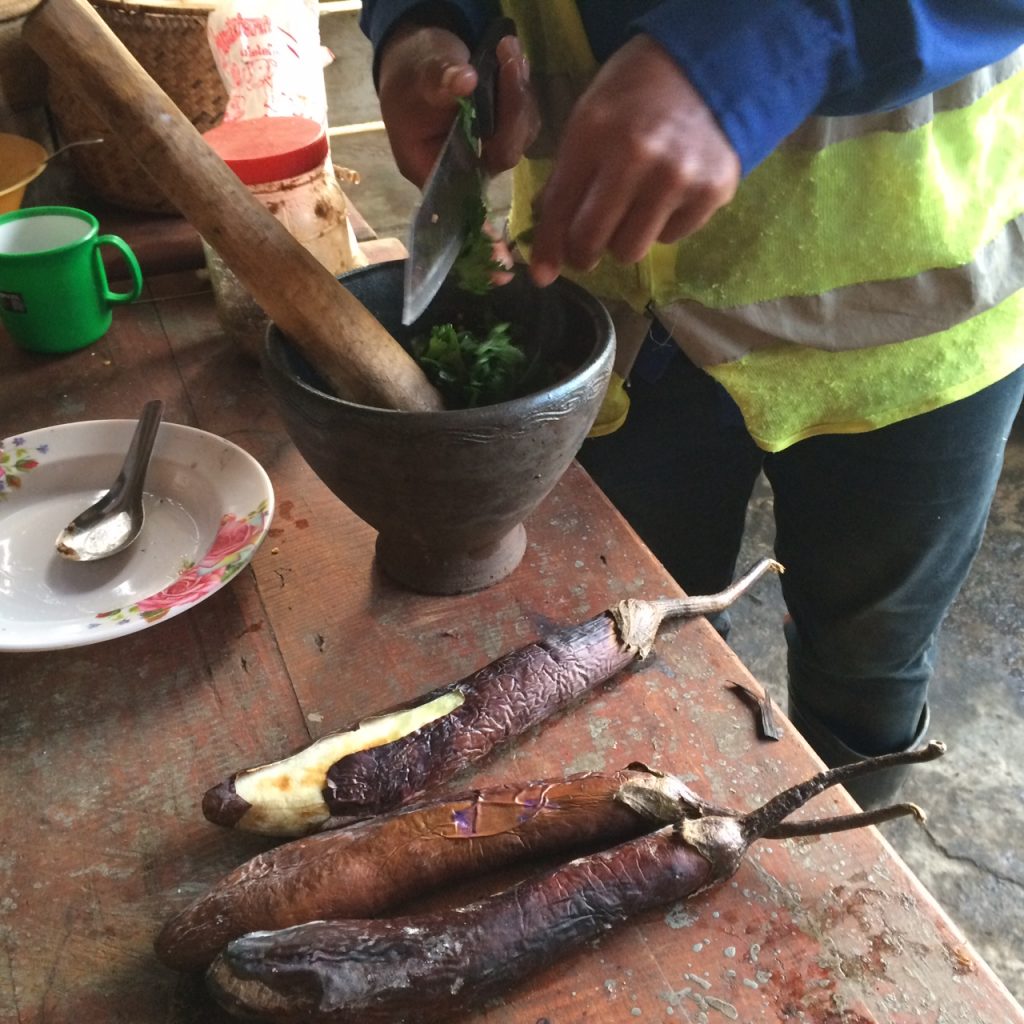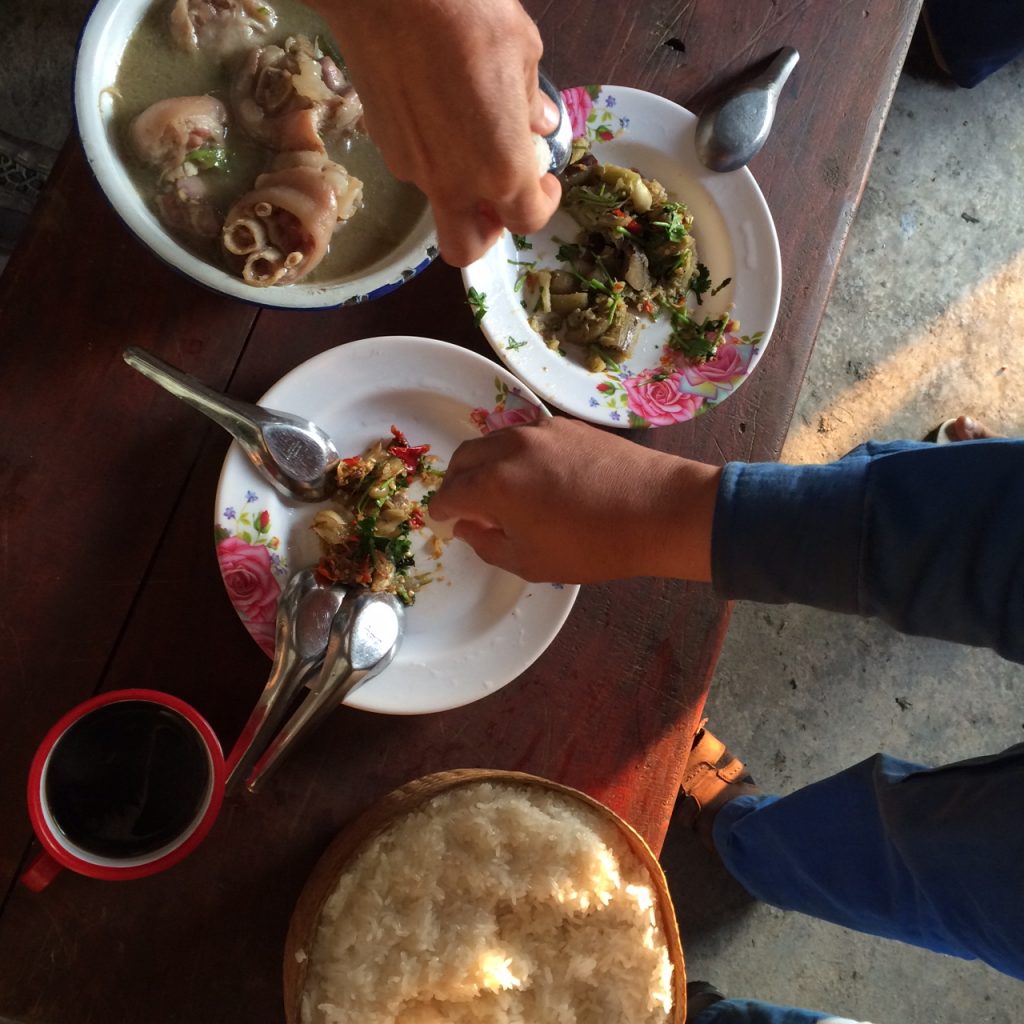Lao Camp Food (Part 1)
I recently spent several days camping with a bomb clearance team in southern Laos. Quick history: Laos, per capita, is the most heavily bombed country on Earth. Between 1964 and 1973, U.S. forces flew more than 580,000 bombing missions over the country in an effort to root out Communists and stop the supply chain along the Ho Chi Minh Trail. Hundreds of millions of bombs were dropped; up to 30 percent did not explode. And they’re still in the ground. Old American bombs have killed and injured more than 20,000 Laotians since the end of the war. It’s dangerous to plow a field, build a road, install a toilet, or dig a ditch. So, every day in Laos, clearance teams scour the soil, looking for bombs.
The team I followed worked with the U.S. nonprofit We Help War Victims to clear farmlands for CARE projects in rural Sekong province. The clearance workers spent each day on the slopes of steep mountains, where subsistence farmers plan to plant coffee, cassava, and other crops. At night, we all camped in a nearby village schoolhouse, turning classrooms into shelters for our tents.
The kitchen was part of the schoolhouse, an airy wooden room with an open view of the rolling landscape. Two fires in the corner burned through much of the day and night. A sturdy wooden table served as an all-purpose workspace: chopping, mincing, pounding, gutting, filleting, and sausage-making. Smoke was constant, both a byproduct of the fuel and a flavor for the food. Everyone ate communally, standing at a long wooden table, sharing giant baskets of sticky rice—the dietary staple—along with plates of salad and bowls of soup. There is a protocol to eating sticky rice: Grab a handful, break off a small chunk, roll it into a bite-sized ball, and dip it into the other dishes.
The nearest market was an hour away over horrendously rutted dirt roads. The team captain periodically made that drive to buy rice, seasonings, and a few packaged goods. But much of what we ate—meat, vegetables, herbs—came from the village or surrounding forest.
I’ve done this camping-with-a-bomb-clearance-team thing twice—first while researching a book, and this time while producing a documentary video. The first time (about six years ago, way up north near the Chinese border), I posted a diary on my blog of everything I ate. Readers responded with interest, so I decided to do it again here.
I’ve identified local and/or unusual produce to the best of my knowledge, using Lao names and links to online descriptions when possible. I’ve listed every dish offered and noted those I did not eat (generally for sanitation reasons). Breakfast and dinner were cooked and eaten in camp; lunch was typically cooked in camp but eaten in the field.
DAY 1
A team member prepares eggplant jaeow, a spicy chile condiment akin to salsa that’s served with most meals.
Lunch:
- canned mackerel and tomato with added fresh green onion, cilantro, chile, and mint
- jaeow (Lao chile paste, akin to salsa, with a base of pounded chiles, fermented fish known as padaek and/or fish sauce, salt, and other ingredients that vary each time)
- sticky rice
- raw fiddlehead ferns from the field
- assorted herbs including cilantro and spade-shaped minty medicinal leaves
Dinner:
- farmed river fish bought in the market stewed with galangal (a relative of ginger), lime leaves, dill, and shallots
- smoky lime jaeow with fire-charred chile, green onion, toasted mak ken (prickly ash berries), roasted garlic, and roasted shallot
- plates of kom (bitter herbs with tiny flower buds)
- dried chile jaeow
- sticky rice
DAY 2
Breakfast:
- Lao-grown coffee
- sticky rice
- herbal fish soup
- jaeow
- charred phia phan (local tree leaves)
Lunch:
- shredded green papaya salad (a common Southeast Asian dish pounded with padaek, chile, tiny pea eggplants, lime, and other ingredients), served with fresh lotus stem
- whole roasted tilapia bought at the market
- sticky rice
- fresh chile in fish sauce
Dinner:
- charred water buffalo skin (a common appetizer) and lao lao (rice whiskey)
- cooked flying squirrel laap (a popular minced meat or fish dish with lots of herbs, lime, and other ingredients)
- raw flying squirrel laap (did not eat; laap is often served raw)
- flying squirrel bowels soup (did not eat)
- jaeow
- phia phan leaves and another type of local leaf
- sticky rice
- mango, rose apple, peanuts, and banana from the market, which we ate together as a snack to supplement our dinner
DAY 3
Breakfast:
- sticky rice
- jaeow
- unidentified innards soup
- pieces of unidentified entrails (didn’t eat)
- coffee
- Larabar (brought from the U.S.)
Lunch (brought from camp to a Vietnamese shop down the mountain, near the team’s work site that day):
- sticky rice
- unidentified innards laap (didn’t eat)
- small squirrel soup
- nuoc mam (Vietnamese fish sauce) and chile (from the shop)
- candied ginger (from the shop)
- peanuts (from the market)
- green tea (from the shop)
- pork slices (from the shop)
Dinner:
- sticky rice
- lao lao
- flying squirrel innards soup with extremely bitter green leaves
- spicy cucumber salad with garlic, chile, and padaek
- canned mackerel with tomato
- fish sauce with chile, and toasted garlic slivers
DAY 4
Breakfast:
- sticky rice
- smoked eggplant jaeow
- pork soup
- coffee
Lunch:
- sticky rice
- chicken soup with galangal
- chicken laap with cilantro, chile, chopped banana flower, galangal, and a local herb with small clover-shaped leaves
Dinner:
- sticky rice
- jaeow
- camp-made pork sausages, grilled (incredibly tasty)
- spicy cucumber salad with cilantro, chile, garlic, and padaek
DAY 5
Breakfast:
- sticky rice
- jaeow
- buffalo meat soup with tender strips of rattan, lemongrass, lime leaves, galangal, and small green eggplants
I salute the team for creating such an aromatic, flavorful menu with limited ingredients. The diary, I think, offers the following insights into rural mountain diets in this remote stretch of the tropics:
- Repetition is the norm: sticky rice and jaeow at every meal, and only slight variations on soups, stews, salads, and meats. My camp food dining ended after a few days, and I was back in a town with restaurants and options. But locals living in these mountains often have no choice beyond what is grown, found, or hunted that day.
- I could use an array of adjectives to describe the dominant flavors of these meals—herbal, grassy, smoky, woody, burnt, bitter, pungent, fishy, animalistic, salty, spicy, hot—but not sweet. There was no fresh fruit, no sugar, no juice in the local diet. The few sweet things we ate, we had bought in a market or store before arriving in camp. I typically don’t have much of a sweet tooth. But after a few days, I craved sugar.
- We ate meat or fish at every meal because the team could afford to buy it from the market or village.
And that leads me to Part 2 of this post.



































